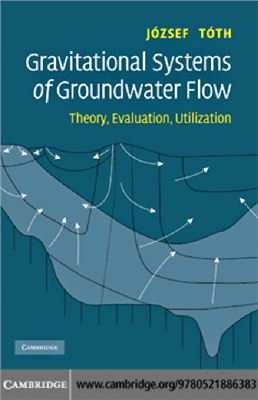CUP, 2009. –311 pp. ISBN 0521886384
Groundwater of meteoric origin permeates the upper parts of the Earth’s crust in spatially organized flow systems down to several kilometres. Since the discovery of the flow-system concept in the 1960s, hydrogeology’s basic paradigm has shifted from confined flow in aquifers to cross-formational flow in drainage basins. Consequently, groundwater has been recognised as a fundamental geologic agent, generating and modifying natural processes and phenomena of scientific, practical and economic interest.
This book is the first to present an extensive and illustrated overview of the history, principles, study methods, practical applications and natural effects of gravity-driven groundwater flow. Its user-friendly presentation requires no advanced background in mathematics, with the necessary mathematics being explained in full, and the physical meaning of the equations emphasized. The author highlights significant inter-relationships between the broad range of seemingly disparate processes and systems, demonstrating how these can be traced to a common root cause involving gravity-driven groundwater flow. Examples are used to illustrate practical applications in areas as diverse as hydrogeology, land-use planning, environment protection, wetland ecology, agriculture, forestry, geotechnical engineering,
nuclear-waste disposal, mineral and petroleum exploration, and geothermal heat flow.
Written by one of the founding fathers of mode hydrogeology, and including an extensive glossary to aid students and researchers from a variety of disciplines, this book is a key reference for researchers, consultants and advanced students of hydrogeology and reservoir engineering.
Groundwater of meteoric origin permeates the upper parts of the Earth’s crust in spatially organized flow systems down to several kilometres. Since the discovery of the flow-system concept in the 1960s, hydrogeology’s basic paradigm has shifted from confined flow in aquifers to cross-formational flow in drainage basins. Consequently, groundwater has been recognised as a fundamental geologic agent, generating and modifying natural processes and phenomena of scientific, practical and economic interest.
This book is the first to present an extensive and illustrated overview of the history, principles, study methods, practical applications and natural effects of gravity-driven groundwater flow. Its user-friendly presentation requires no advanced background in mathematics, with the necessary mathematics being explained in full, and the physical meaning of the equations emphasized. The author highlights significant inter-relationships between the broad range of seemingly disparate processes and systems, demonstrating how these can be traced to a common root cause involving gravity-driven groundwater flow. Examples are used to illustrate practical applications in areas as diverse as hydrogeology, land-use planning, environment protection, wetland ecology, agriculture, forestry, geotechnical engineering,
nuclear-waste disposal, mineral and petroleum exploration, and geothermal heat flow.
Written by one of the founding fathers of mode hydrogeology, and including an extensive glossary to aid students and researchers from a variety of disciplines, this book is a key reference for researchers, consultants and advanced students of hydrogeology and reservoir engineering.

